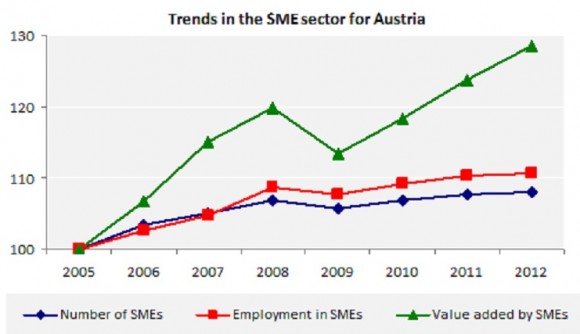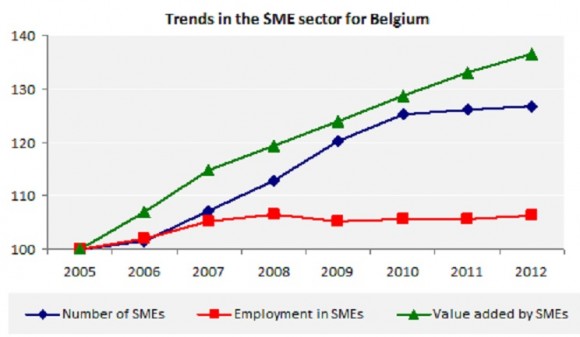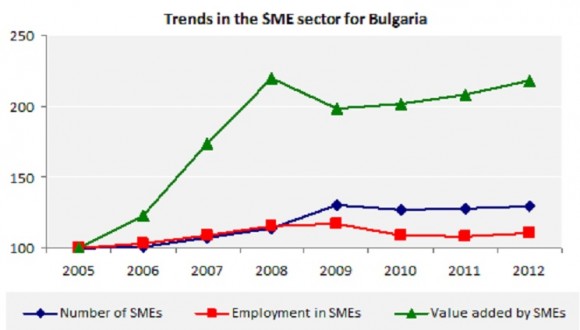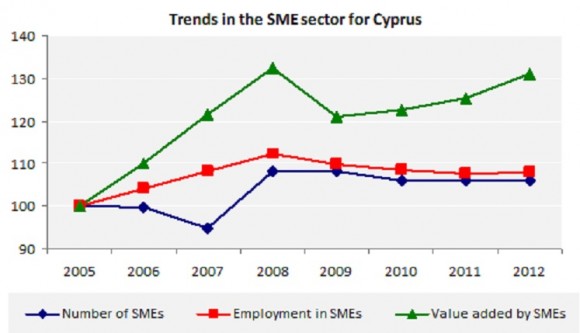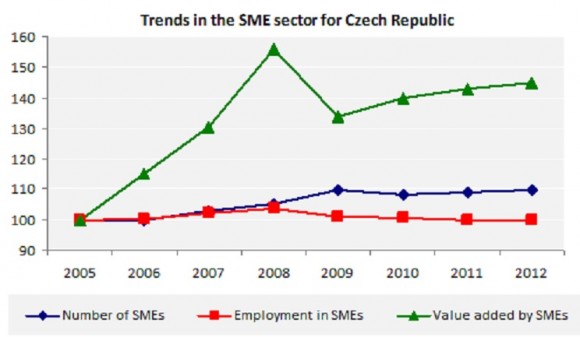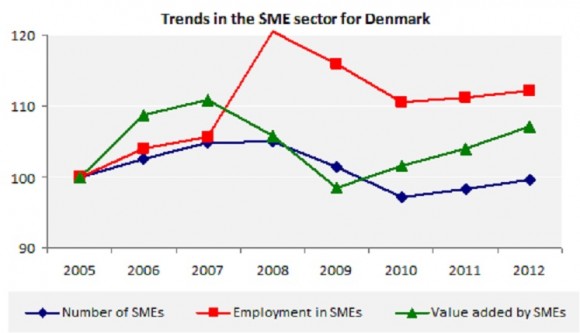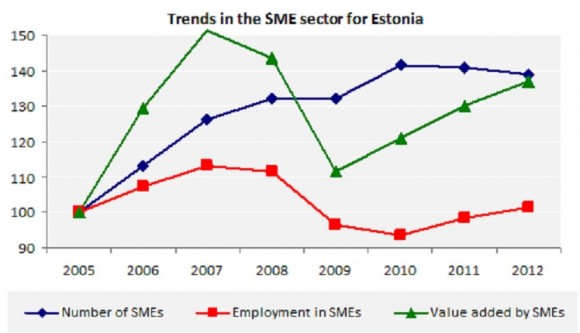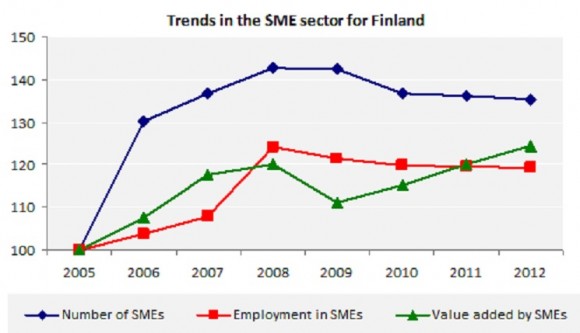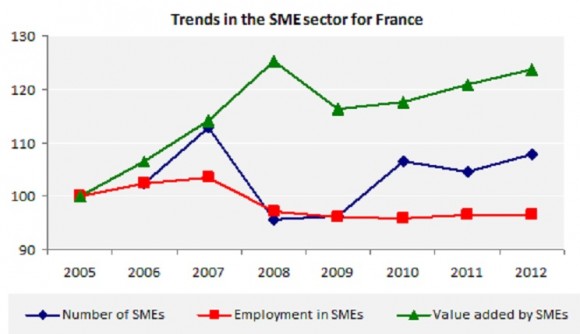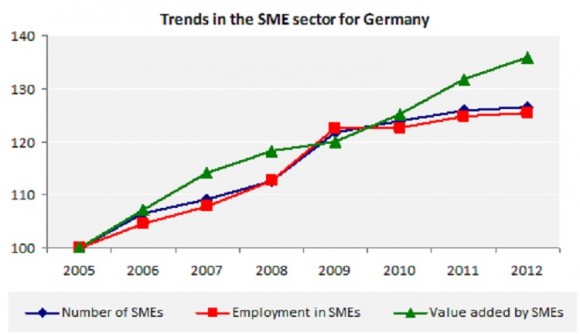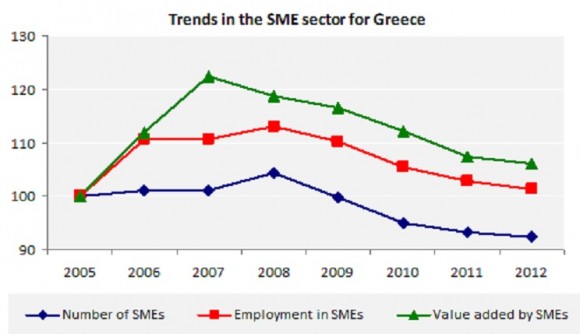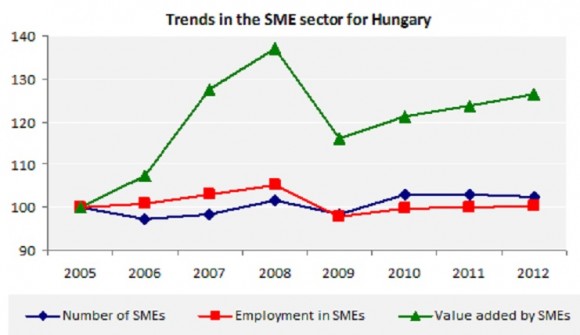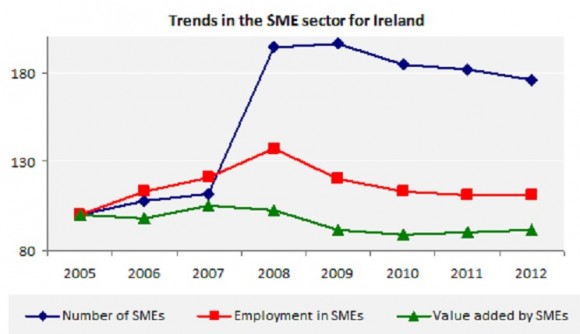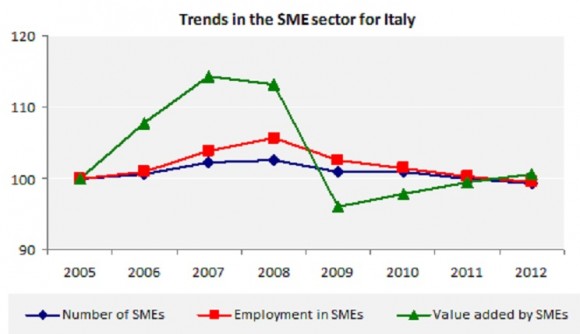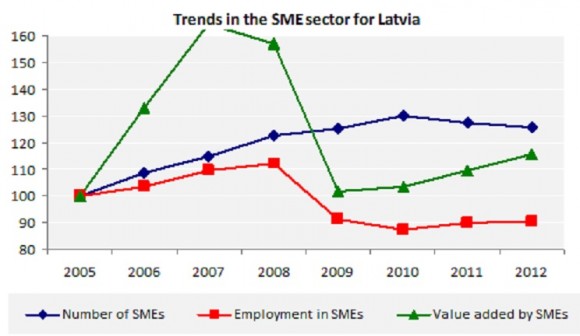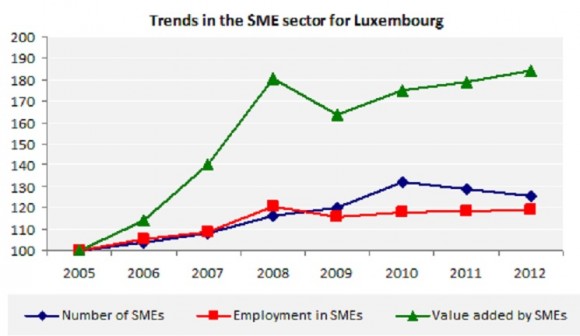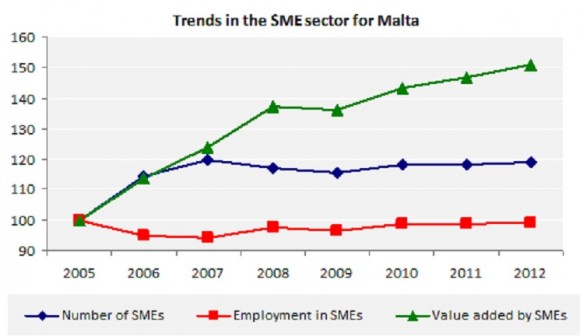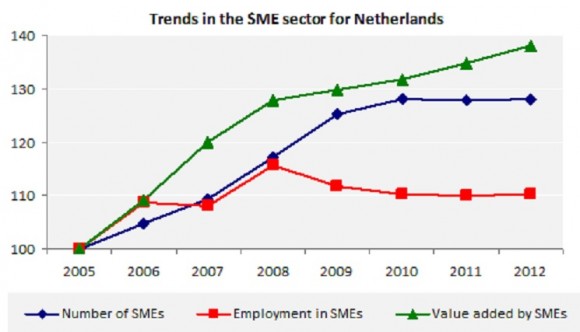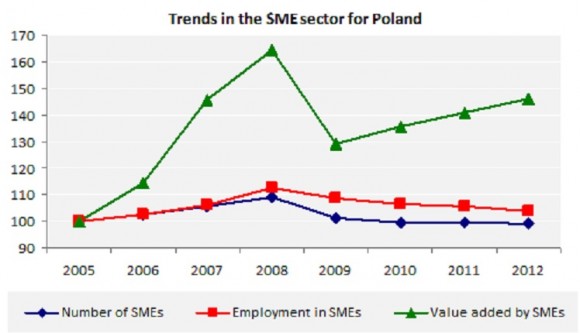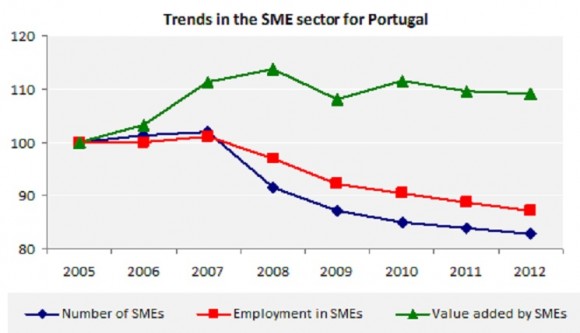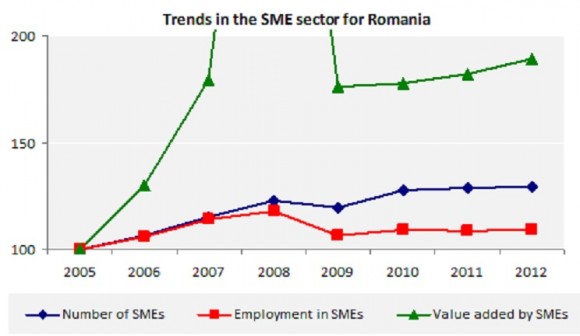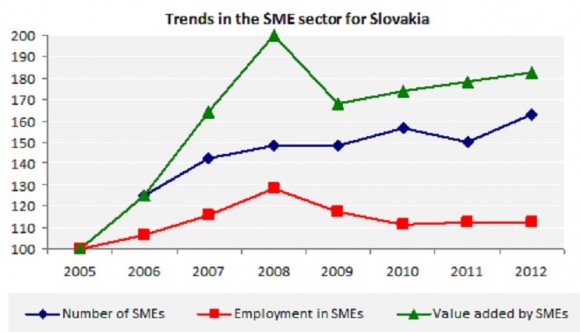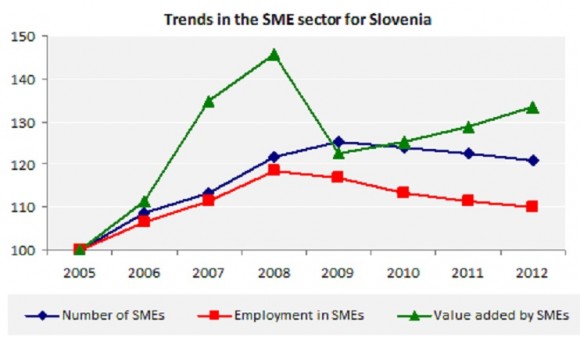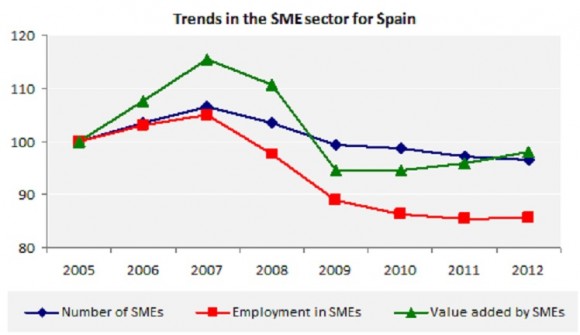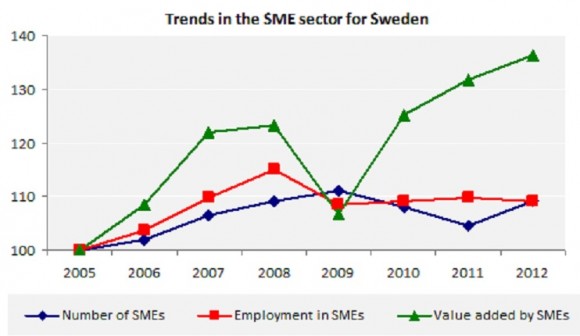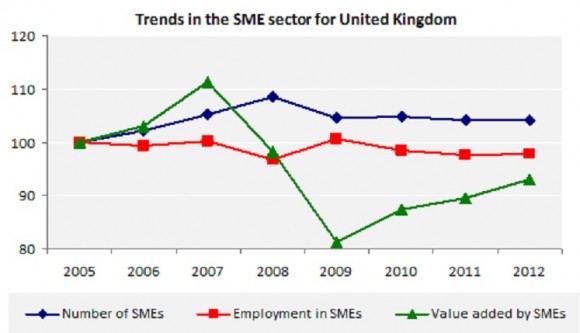18-10-2012 — /europawire.eu/ — The Commission annually assesses progress in implementation of the Small Business Act (SBA)1 at national level. This memo describes the results of the assessment as illustrated by country specific SBA factsheets2, composed on the basis of a wide range of success indicators and national policy developments and grouped according to the SBA’s ten policy dimensions. These policy dimensions are: (1) Entrepreneurship, (2) Second chance, (3) Think Small First, (4) Responsive Administration, (5) State aid and Public procurement, (6) Access to finance, (7) Single market, (8) Skills and innovations, (9) Environment, and (10) Internationalization. The SBA factsheets cover the 27 EU Member States, as well as Albania, Croatia, FYROM, Iceland, Israel, Liechtenstein, Norway, Montenegro, Serbia and Turkey.
Country highlights
Austria
- SMEs in Austria represent 99.7% of all businesses and account for 60.8% of the economic added value and 67.9% of employment in the non-financial private sector. 30% of Austrian SMEs are active in high-tech manufacturing and knowledge intensive service sectors which are considered key for the future competitiveness of the country.
- Austria is one of the few EU Member States where the SME sector has, so far, weathered the crisis without any lasting downturn. All key SME indicators have returned to and even surpassed pre-crisis levels (2008). Of these, the economic added value has shown the most impressive development, with an average annual growth rate of 4% since 2009.
- For 2012, forecasts point towards a growth of 0.2% in the number of SMEs, 3.8% in gross value added and of 0.3% in employment.
- Austria’s SBA performance is particularly strong in three areas, namely Think Small First, Skills & innovation and Access to finance.
- In 2011, Austria took policy action in a majority of SBA areas, focusing in particular on public procurement reform and enhancing R&D competencies in SMEs.
Belgium
- SMEs in Belgium represent 99.8% of all businesses and account for 61.6% of the economic added value and 67.7% of employment in the private non-financial sector. 29% of SMEs are active in the high-tech manufacturing and knowledge intensive service sectors which are considered key for the future competitiveness of the country.
- The Belgian SME sector does not differ substantially from the EU-wide one, except for a slight prevalence of micro enterprises in the total number of SMEs.
- SMEs in Belgium have coped with the crisis better than in the EU as a whole, in particular in terms of value added with an average annual growth rate of more than 3% since 2009.
- Policy efforts seem well targeted, since many are focused on the SBA area with the lowest scores (Entrepreneurship) or a negative trend (Internationalisation and Access to finance).
Bulgaria
- SMEs in Bulgaria represent 99.8% of all businesses and account for 61.9% of the economic added value and 75.7% of employment in the private non-financial sector. 16% of SMEs are active in the high-tech manufacturing and knowledge intensive service sectors which are considered key for the future competitiveness of the country.
- Bulgarian SMEs tend to be larger across all size classes than their EU peers. The sector they are most likely to be active in is trade, rather than services, as in the EU as a whole.
- The Bulgarian SME sector has stabilised after the crisis with noticeably more businesses, jobs and value added than the EU as a whole, compared with the base year 2005
- While the government has not yet adopted a national strategy to implement the Small Business Act, significant measures have been taken, especially in the areas of ‘Responsive administration’, ‘Single market’ and ‘Think small first’. Yet Bulgaria still lags behind in five SBA areas (‘Second chance’, ‘Environment’, ‘Internationalisation’, ‘Entrepreneurship’ and ‘Skills and innovation’).
Cyprus
- SMEs in Cyprus represent 99.8% of all businesses and account for 76.0% of the economic added value and 81.4% of employment in the private non-financial sector. 14% of SMEs are active in the high-tech manufacturing and knowledge intensive service sectors which are considered key for the future competitiveness of the country.
- Although forecasts show a positive trend in economic value added, the number of SMEs and their employment figures are still below pre-crisis 2008 values.
- Cyprus is in line with the EU average in most SBA areas, with the exception of “Environment” and “Responsive administration”, where it is still lagging behind.
- Cyprus performs best in “Entrepreneurship” and “Internationalisation” but it has a lot of catching up to do to reach the level of the EU’s best performers on the remaining SBA areas.
The Czech Republic
- SMEs in Czech Republic represent 99.9% of all businesses and account for 55.9% of the economic added value and 69.9% of employment in the private non-financial sector. 29% of SMEs are active in the high-tech manufacturing and knowledge intensive service sectors which are considered key for the future competitiveness of the country.
- Micro-firms have a strong presence in the SME sector. All SME indicators are still below pre-crisis 2008 levels, and only the economic value added is on a clear positive trend.
- The Czech Republic’s SBA profile has improved in Entrepreneurship, Access to finance, Skills and innovation and Internationalisation, but only scores slightly above average in Skills and innovation.
- In 2012, the Czech Republic was active with specific policy measures in all SBA areas.
Denmark
- SMEs in Denmark represent 99.6% of all businesses and account for 64.2% of the economic added value and 66.2% of employment in the private non-financial sector. 30% of SMEs are active in the high-tech manufacturing and knowledge intensive service sectors which are considered key for the future competitiveness of the country.
- The SME’s sector contribution to the economy in terms of gross value-added has bucked the downward trend of 2009 and is now on a steady growth path, similar to the EU-average.
- The SBA profile for Denmark clearly exceeds the EU average in all but two domains (Environment and Entrepreneurship).
- Denmark tops all other EU countries in Skills and innovation and Internationalisation.
Estonia
- SMEs in Estonia represent 99.7% of all businesses and account for 71.6% of the economic added value and 77.6% of employment in the private non-financial sector. 27% of SMEs are active in the high-tech manufacturing and knowledge intensive service sectors which are considered key for the future competitiveness of the country.
- The SME sector is recovering slowly, in particular as concerns the gross value added, and, to a more limited extent, employment trends.
- SBA performance has improved in areas such as Responsive Administration and Skills and Innovation.
- In 2011 and in the first quarter of 2012, Estonia took action in eight out of ten SBA areas, focusing on Think Small First.
Finland
- SMEs in Finland represent 99.7% of all businesses and account for 57.0% of the economic added value and 61.7% of employment in the private non-financial sector. 27% of SMEs are active in the high-tech manufacturing and knowledge intensive service sectors which are considered key for the future competitiveness of the country. Moreover, 28 % of all SME manufacturing jobs are in high-tech or medium- to high-tech activities
- The outlook for Finnish SMEs until the end of 2012 is stable and relatively good, with positive trends for gross value added.
- Finland boasts one of the best SBA profiles of all EU-27 countries with a top performance in 4 out of 10 policy areas. Further stimulation of SMEs trade performance within and outside the single market may be the only challenge.
France
- SMEs in France represent 99.8% of all businesses and account for 59.0% of the economic added value and 63.9% of employment in the private non-financial sector. 21% of SMEs are active in the high-tech manufacturing and knowledge intensive service sectors which are considered key for the future competitiveness of the country.
- The French SME sector does not differ substantially from the Europe-wide one, except that micro-firms are more prevalent and more productive in France.
- The SME sector is coping well with the crisis in terms of the numbers of firms and their value added, but employment in SMEs continues on a downward, albeit slow-moving, path.
- France scores better than the EU average on two of the ten SBA principles, namely Responsive administration and Internationalisation, and it is average for the remaining eight. In 2011, France’s policy focused on tackling the lack of competitiveness of industrial firms, in particular SMEs.
Germany
- SMEs in Germany represent 99.5% of all businesses and account for 53.9% of the economic added value and 62.7% of employment in the private non-financial sector. 26% of SMEs are active in the high-tech manufacturing and knowledge intensive service sectors which are considered key for the future competitiveness of the country.
- Germany’s SME sector is one of the fastest expanding in the entire EU.
- Its SBA performance is above the EU average in terms of high-tech manufacturing, but only average on knowledge-intensive services.
- Conditions for SMEs in almost all policy domains are better than in the EU on average, with the promotion of entrepreneurship being the only area of concern.
Greece
- SMEs in Greece represent 99.9% of all businesses and account for 69.9% of the economic added value and 85.1% of employment in the private non-financial sector. 24% of SMEs are active in the high-tech manufacturing and knowledge intensive service sectors which are considered key for the future competitiveness of the country.
- The SME sector is more important in Greece than in the average EU country, and Greek SMEs tend to be smaller than their EU peers.
- The crisis has caused a dramatic decrease in the number of Greek SMEs, estimated to be 90 000 thousand units between 2008 and 2011.
- Greece lags behind the EU average by a considerable margin in five out of ten SBA areas.
- Recently, important policy measures have been taken in the SBA areas of Access to finance, Internationalisation, Second chance, Responsive administration and Skills and innovation.
Hungary
- SMEs in Hungary represent 99.9% of all businesses and account for 53.8% of the economic added value and 72.7% of employment in the private non-financial sector. 35% of SMEs are active in the high-tech manufacturing and knowledge intensive service sectors which are considered key for the future competitiveness of the country.
- The SME sector has been stagnant in Hungary since at least 2005 in terms of number of enterprises and employment. Micro-firms are of particular importance as they provide more than 36% of the business economy.
- Hungary is still trailing the EU-average in 8 out of 10 SBA areas, although in many there has been a recent gradual improvement of the situation.
- The Government is remaining active on SME policy, but some selected measures threaten to have a detrimental effect on SMEs.
Ireland
- SMEs in Ireland represent 99.7% of all businesses and account for 51.5% of the economic added value and 69.0% of employment in the private non-financial sector. 31% of SMEs are active in the high-tech manufacturing and knowledge intensive service sectors which are considered key for the future competitiveness of the country.
- Small and medium-sized enterprises are comparatively more prevalent in Ireland than in the EU as a whole. The Irish SME sector is still struggling with the effects of the crisis. Employment stabilised in 2010/2011 and value added is now on a very modest growth path, but still well below pre-crisis levels.
- The country clearly outstrips the EU average in six out of 10 SBA areas. It offers by far the best conditions for entrepreneurs who have failed and want to start over again. In 2011, policy measures were focused on improving access to finance for SMEs and second-chance entrepreneurs.
Italy
- SMEs in Italy represent 99.9% of all businesses and account for 68.3% of the economic added value and 80.3% of employment in the private non-financial sector. 26% of SMEs are active in the high-tech manufacturing and knowledge intensive service sectors which are considered key for the future competitiveness of the country.
- Italy’s SME sector — the largest in the EU by number of firms — is dominated by 3.6 million micro-firms with less than 10 employees.Italian SMEs have trailed their EU peers in recovering from the crisis, and this is set to continue.
- In most SBA policy areas Italy has yet to catch up with the EU average.
- Some important policy measures introduced over the last year may prove vital in starting a sustained turn-around of Italy’s SME sector.
Latvia
- SMEs in Latvia represent 99.8% of all businesses and account for 65.8% of the economic added value and 77.4% of employment in the private non-financial sector. 24% of SMEs are active in the high-tech manufacturing and knowledge intensive service sectors which are considered key for the future competitiveness of the country.
- Latvian SMEs tend to have more employees than in the EU on average, but the gap has been closing over recent years.
- The crisis has hit Latvian SMEs particularly hard in terms of their ability to provide jobs.
- Latvia’s SBA profile shows clear signs of improvement over time, especially as regards State aid & public procurement and Single market
- In 2011, Latvia was active with specific policy measures in a majority of SBA areas.
Lithuania
- SMEs in Lithuania represent 99.8% of all businesses and account for 63.4% of the economic added value and 75.7% of employment in the private non-financial sector. 17% of SMEs are active in the high-tech manufacturing and knowledge intensive service sectors which are considered key for the future competitiveness of the country.
- The Lithuanian SME sector comprises fewer micro firms and small and medium-sized ones than the EU average. SMEs were hit by the crisis but less so than larger enterprises.
- Lithuania’s SBA profile is largely in line with the EU average, but on a positive trend.
- In 2011, policy actions were taken in most SBA areas, in particular Responsive administration, Entrepreneurship and Second chance.
Luxembourg
- SMEs in Luxembourg represent 99.5% of all businesses and account for 72.8% of the economic added value and 67.8% of employment in the private non-financial sector. 36% of SMEs are active in the high-tech manufacturing and knowledge intensive service sectors which are considered key for the future competitiveness of the country.
- Luxembourg’s SME sector has weathered the crisis much better than most others in the EU, shedding no more than an estimated 4200 jobs between the pre-crisis peak in 2008 and the end of 2012.
- The service sector dominates much more than in other EU countries, even excluding financial services.
- SBA implementation remains on course, with most progress in 2011 being made in ‘Entrepreneurship’ and ‘Responsive administration’.
- Future challenges include the further improvement of ‘Second chance’ conditions and the simplification of administrative measures.
Malta
- SMEs in Malta represent 99.9% of all businesses and account for 64.5% of the economic added value and 76.3% of employment in the private non-financial sector. 25% of SMEs are active in the high-tech manufacturing and knowledge intensive service sectors which are considered key for the future competitiveness of the country.
- Micro-firms of less than 10 employees are crucially important for Malta´s SME sector.
- Forecasts until the end of 2012 see Malta´s SMEs continuing to weather the crisis well.
- Progress in SBA implementation, especially in the areas “Think small first” and “Access to finance”.
Netherlands
- SMEs in Netherlands represent 99.7% of all businesses and account for 63.2% of the economic added value and 65.4% of employment in the private non-financial sector. 40% of SMEs are active in the high-tech manufacturing and knowledge intensive service sectors which are considered key for the future competitiveness of the country.
- Dutch SMEs are particularly strong in knowledge-intensive professional services, accounting for 26% of all service employment. However, they are only average in terms of hi-tech and innovative manufacturing or services activities.
- The outlook for Dutch small or medium-size enterprises (SMEs) is stable until the end of 2012. They have shed more than 200 000 jobs since 2009.
- Netherlands has a strong profile in SBA policy areas such as ‘Second Chance’, ‘Think small first’, ‘Environment’ and ‘Internationalisation’, but ‘Access to finance’ remains a concern.
Poland
- SMEs in Poland represent 99.8% of all businesses and account for 51.5% of the economic added value and 68.2% of employment in the private non-financial sector. 22% of SMEs are active in the high-tech manufacturing and knowledge intensive service sectors which are considered key for the future competitiveness of the country.
- The SME sector has been severely affected by the crisis. Of the key SME indicator, only the gross value added has bounced back, but still remains below pre-crisis 2008 levels.
- Despite improvements over previous years, the SBA profile for Poland still lags behind the EU average for several areas. Performance is particularly good in: ‘Entrepreneurship’ and ‘Access to Finance’, but ‘Internationalisation’ and ‘Skills and innovation’ need attention.
- In 2011, Poland initiated a battery of actions and implemented measures in all SBA areas, except ‘Public procurement and state aid’, ‘Single market’ and ‘Environment’.
Portugal
- SMEs in Portugal represent 99.9% of all businesses and account for 67.6% of the economic added value and 78.3% of employment in the private non-financial sector. 24% of SMEs are active in the high-tech manufacturing and knowledge intensive service sectors which are considered key for the future competitiveness of the country.
- Portugal’s SMEs have been severely hit by recession with no rebound in sight until the end of 2012. Hardest hit are micro-firms employing less than 10 persons and representing 94 % of all businesses.
- Amid a challenging political and economic climate, Portugal’s overall SBA profile has improved slightly over the last year.
- Important policy initiatives have been taken in the ‘Entrepreneurship’ and ‘Second chance’ areas.
Romania
- SMEs in Romania represent 99.7% of all businesses and account for 52.7% of the economic added value and 67.2% of employment in the private non-financial sector. 20% of SMEs are active in the high-tech manufacturing and knowledge intensive service sectors which are considered key for the future competitiveness of the country.
- Small and medium-sized businesses are comparatively more prevalent in Romania compared to the EU as a whole. The Romanian SME sector is slowly recovering from the crisis. Employment and value added have stabilized in 2010/2011, although they are still well below pre-crisis levels.
- Romania scores under the EU average for seven SBA principles, with only ‘Entrepreneurship’ above average. In 2011, Romania addressed eight out of ten SBA areas through targeted policy measures, with the main focus on entrepreneurship and responsive administration.
Slovakia
- SMEs in Slovakia represent 99.2% of all businesses and account for 52.2% of the economic added value and 58.3% of employment in the private non-financial sector. 22% of SMEs are active in the high-tech manufacturing and knowledge intensive service sectors which are considered key for the future competitiveness of the country.
- There are comparatively more small businesses in Slovakia than in the EU on average.
- The Slovak SME sector is slowly recovering from the crisis. Employment stabilised in 2010/2011 and value-added is now on a modest growth path, albeit still well below pre-crisis levels.
- Overall, the statistics on SMEs reveal a modest SBA profile for Slovakia. The only area in which the country performs better than the EU average is in making use of the advantages offered by the Single market. For the remaining areas it scores below average.
Slovenia
- SMEs in Slovenia represent 99.8% of all businesses and account for 63.0% of the economic added value and 70.6% of employment in the private non-financial sector. 33% of SMEs are active in the high-tech manufacturing and knowledge intensive service sectors which are considered key for the future competitiveness of the country.
- The Slovenian SME sector outdoes its EU counterparts in terms of employment and contribution to the economy.
- The SMEs are slowly recovering from the crisis. Employment stabilised somewhat in 2010/2011 and value-added is continuing on a modest growth path after the 2009 slump, though current levels are still below the 2008 peaks.
- Overall, the statistics on SMEs give an average SBA profile for Slovenia. In 2011, Slovenia’s policy record was characterised by some — albeit limited — progress, with the most significant initiatives in Access to finance and Skills and innovation.
Spain
- SMEs in Spain represent 99.9% of all businesses and account for 65.7% of the economic added value and 75.6% of employment in the private non-financial sector. 22% of SMEs are active in the high-tech manufacturing and knowledge intensive service sectors which are considered key for the future competitiveness of the country.
- Spanish SMEs are still struggling with the impact of the deep recession and persistent unemployment.
- Spain scores better than the EU in only one SBA area, ‘Think small first’. On the other aspects, it scores either on par with the average (Second chance, Responsive administration, Environment) or below average.
- In 2011, Spain achieved a more balanced development across the SBA aspects, taking policy action in most areas. Due to the current economic crisis, the government passed new measures to help credit flow into the real economy, remove administrative charges and boost the competitiveness of Spanish firms by investing in R&D.
Sweden
- SMEs in Sweden represent 99.8% of all businesses and account for 58.4% of the economic added value and 64.3% of employment in the private non-financial sector. 33% of SMEs are active in the high-tech manufacturing and knowledge intensive service sectors which are considered key for the future competitiveness of the country.
- Swedish SMEs are weathering the crisis better than their EU peers.
- The structure of the SME sector in Sweden closely mirrors that across the EU.
- The SBA performance of Sweden is very good, with above average results in seven out of the ten SBA areas.
- Policy-wise, in 2011 Sweden was particularly active in the SBA areas of ‘Entrepreneurship’ and ‘Second chance’.
United Kingdom
- SMEs in United Kingdom represent 99.6% of all businesses and account for 49.5% of the economic added value and 54.3% of employment in the private non-financial sector. 37% of SMEs are active in the high-tech manufacturing and knowledge intensive service sectors which are considered key for the future competitiveness of the country.
- The SME sector is still struggling to cope with the crisis. Of the key SME indicators, only the gross value added is now on a steady positive trend.
- SBA performance is particularly good in the areas ‘Environment’, ‘Skills and Innovation’ and ‘Responsive Administration’.
- In 2011, the UK focused SBA action on Entrepreneurship.
Adopted in 2008 and revised in 2011, the SBA aims to create a level playing field for SMEs throughout the EU and improve the administrative and legal environment to allow these enterprises to unleash their full potential to create jobs and growth. The Small Business Act has a strong governance structure, with business organizations and member states governments at the frontline.
The information concerning the recent policy measures adopted by the member states was compiled by a network of SME experts managed by Ecorys Netherlands and was validated by Government representatives of the member states and the participating countries. The factsheets were prepared by the European Commission’s Directorate-General for Enterprise and Industry, in conjunction with the Joint Research Centre.
###
- Digi Communications N.V. announces signing of the business and asset transfer agreement between DIGI Romania, Vodafone Romania, Telekom Romania Mobile Communications, and Hellenic Telecommunications Organization
- Sparkoz to showcase next-generation autonomous cleaning robots at CMS Berlin 2025
- Digi Communications N.V. announces clarifications on recent press articles regarding Digi Spain S.L.U.
- Netmore Assumes Commercial Operations of American Tower LoRaWAN Network in Brazil in Strategic Transition
- Cabbidder launches to make UK airport transfers and long-distance taxi journeys cheaper and easier for customers ↗️
- Robert Szustkowski appeals to the Prime Minister of Poland for protection amid a wave of hate speech
- Digi Communications NV announces the release of H1 2025 Financial Report
- Digi Communications NV announces “Investors Call for the presentation of the H1 2025 Financial Results”
- As Brands React to US Tariffs, CommerceIQ Offers Data-Driven Insights for Expansion Into European Markets
- Digi Communications N.V. announces „The Competition Council approves the acquisition of the assets and of the shares of Telekom Romania Mobile Communications by DIGI Romania and Vodafone Romania”
- HTR makes available engineering models of full-metal elastic Lunar wheels
- Tribunal de EE.UU. advierte a Ricardo Salinas: cumpla o enfrentará multas y cárcel por desacatoo
- Digi Communications N.V. announces corporate restructuring of Digi Group’s affiliated companies in Belgium
- Aortic Aneurysms: EU-funded Pandora Project Brings In-Silico Modelling to Aid Surgeons
- BREAKING NEWS: New Podcast “Spreading the Good BUZZ” Hosted by Josh and Heidi Case Launches July 7th with Explosive Global Reach and a Mission to Transform Lives Through Hope and Community in Recovery
- Cha Cha Cha kohtub krüptomaailmaga: Winz.io teeb koostööd Euroopa visionääri ja staari Käärijäga
- Digi Communications N.V. announces Conditional stock options granted to Executive Directors of the Company, for the year 2025, based on the general shareholders’ meeting approval from 25 June 20244
- Cha Cha Cha meets crypto: Winz.io partners with European visionary star Käärijä
- Digi Communications N.V. announces the exercise of conditional share options by the executive directors of the Company, for the year 2024, as approved by the Company’s OGSM from 25 June 2024
- “Su Fortuna Se Ha Construido A Base de La Defraudación Fiscal”: Críticas Resurgen Contra Ricardo Salinas en Medio de Nuevas Revelaciones Judiciales y Fiscaleso
- Digi Communications N.V. announces the availability of the instruction regarding the payment of share dividend for the 2024 financial year
- SOILRES project launches to revive Europe’s soils and future-proof farming
- Josh Case, ancien cadre d’ENGIE Amérique du Nord, PDG de Photosol US Renewable Energy et consultant d’EDF Amérique du Nord, engage aujourd’hui toute son énergie dans la lutte contre la dépendance
- Bizzy startet den AI Sales Agent in Deutschland: ein intelligenter Agent zur Automatisierung der Vertriebspipeline
- Bizzy lance son agent commercial en France : un assistant intelligent qui automatise la prospection
- Bizzy lancia l’AI Sales Agent in Italia: un agente intelligente che automatizza la pipeline di vendita
- Bizzy lanceert AI Sales Agent in Nederland: slimme assistent automatiseert de sales pipeline
- Bizzy startet AI Sales Agent in Österreich: ein smarter Agent, der die Sales-Pipeline automatisiert
- Bizzy wprowadza AI Sales Agent w Polsce: inteligentny agent, który automatyzuje budowę lejka sprzedaży
- Bizzy lanza su AI Sales Agent en España: un agente inteligente que automatiza la generación del pipeline de ventas
- Bizzy launches AI Sales Agent in the UK: a smart assistant that automates sales pipeline generation
- As Sober.Buzz Community Explodes Its Growth Globally it is Announcing “Spreading the Good BUZZ” Podcast Hosted by Josh Case Debuting July 7th
- Digi Communications N.V. announces the OGMS resolutions and the availability of the approved 2024 Annual Report
- Escándalo Judicial en Aumento Alarma a la Opinión Pública: Suprema Corte de México Enfrenta Acusaciones de Favoritismo hacia el Aspirante a Magnate Ricardo Salinas Pliego
- Winz.io Named AskGamblers’ Best Casino 2025
- Kissflow Doubles Down on Germany as a Strategic Growth Market with New AI Features and Enterprise Focus
- Digi Communications N.V. announces Share transaction made by a Non-Executive Director of the Company with class B shares
- Salinas Pliego Intenta Frenar Investigaciones Financieras: UIF y Expertos en Corrupción Prenden Alarmas
- Digital integrity at risk: EU Initiative to strengthen the Right to be forgotten gains momentum
- Orden Propuesta De Arresto E Incautación Contra Ricardo Salinas En Corte De EE.UU
- Digi Communications N.V. announced that Serghei Bulgac, CEO and Executive Director, sold 15,000 class B shares of the company’s stock
- PFMcrypto lancia un sistema di ottimizzazione del reddito basato sull’intelligenza artificiale: il mining di Bitcoin non è mai stato così facile
- Azteca Comunicaciones en Quiebra en Colombia: ¿Un Presagio para Banco Azteca?
- OptiSigns anuncia su expansión Europea
- OptiSigns annonce son expansion européenne
- OptiSigns kündigt europäische Expansion an
- OptiSigns Announces European Expansion
- Digi Communications NV announces release of Q1 2025 financial report
- Banco Azteca y Ricardo Salinas Pliego: Nuevas Revelaciones Aumentan la Preocupación por Riesgos Legales y Financieros
- Digi Communications NV announces Investors Call for the presentation of the Q1 2025 Financial Results
- Digi Communications N.V. announces the publication of the 2024 Annual Financial Report and convocation of the Company’s general shareholders meeting for June 18, 2025, for the approval of, among others, the 2024 Annual Financial Report, available on the Company’s website
- La Suprema Corte Sanciona a Ricardo Salinas de Grupo Elektra por Obstrucción Legal
- Digi Communications N.V. announces the conclusion of an Incremental to the Senior Facilities Agreement dated 21 April 2023
- 5P Europe Foundation: New Initiative for African Children
- 28-Mar-2025: Digi Communications N.V. announces the conclusion of Facilities Agreements by companies within Digi Group
- Aeroluxe Expeditions Enters U.S. Market with High-Touch Private Jet Journeys—At a More Accessible Price ↗️
- SABIO GROUP TAKES IT’S ‘DISRUPT’ CX PROGRAMME ACROSS EUROPE
- EU must invest in high-quality journalism and fact-checking tools to stop disinformation
- ¿Está Banco Azteca al borde de la quiebra o de una intervención gubernamental? Preocupaciones crecientes sobre la inestabilidad financiera
- Netmore and Zenze Partner to Deploy LoRaWAN® Networks for Cargo and Asset Monitoring at Ports and Terminals Worldwide
- Rise Point Capital: Co-investing with Independent Sponsors to Unlock International Investment Opportunities
- Netmore Launches Metering-as-a-Service to Accelerate Smart Metering for Water and Gas Utilities
- Digi Communications N.V. announces that a share transaction was made by a Non-Executive Director of the Company with class B shares
- La Ballata del Trasimeno: Il Mediometraggio si Trasforma in Mini Serie
- Digi Communications NV Announces Availability of 2024 Preliminary Financial Report
- Digi Communications N.V. announces the recent evolution and performance of the Company’s subsidiary in Spain
- BevZero Equipment Sales and Distribution Enhances Dealcoholization Capabilities with New ClearAlc 300 l/h Demonstration Unit in Spain Facility
- Digi Communications NV announces Investors Call for the presentation of the 2024 Preliminary Financial Results
- Reuters webinar: Omnibus regulation Reuters post-analysis
- Patients as Partners® Europe Launches the 9th Annual Event with 2025 Keynotes, Featured Speakers and Topics
- eVTOLUTION: Pioneering the Future of Urban Air Mobility
- Reuters webinar: Effective Sustainability Data Governance
- Las acusaciones de fraude contra Ricardo Salinas no son nuevas: una perspectiva histórica sobre los problemas legales del multimillonario
- Digi Communications N.V. Announces the release of the Financial Calendar for 2025
- USA Court Lambasts Ricardo Salinas Pliego For Contempt Of Court Order
- 3D Electronics: A New Frontier of Product Differentiation, Thinks IDTechEx
- Ringier Axel Springer Polska Faces Lawsuit for Over PLN 54 million
- Digi Communications N.V. announces the availability of the report on corporate income tax information for the financial year ending December 31, 2023
- Unlocking the Multi-Million-Dollar Opportunities in Quantum Computing
- Digi Communications N.V. Announces the Conclusion of Facilities Agreements by Companies within Digi Group
- The Hidden Gem of Deep Plane Facelifts
- KAZANU: Redefining Naturist Hospitality in Saint Martin ↗️
- New IDTechEx Report Predicts Regulatory Shifts Will Transform the Electric Light Commercial Vehicle Market
- Almost 1 in 4 Planes Sold in 2045 to be Battery Electric, Finds IDTechEx Sustainable Aviation Market Report
- Digi Communications N.V. announces the release of Q3 2024 financial results
- Digi Communications NV announces Investors Call for the presentation of the Q3 2024 Financial Results
- Pilot and Electriq Global announce collaboration to explore deployment of proprietary hydrogen transport, storage and power generation technology
- Digi Communications N.V. announces the conclusion of a Memorandum of Understanding by its subsidiary in Romania
- Digi Communications N.V. announces that the Company’s Portuguese subsidiary finalised the transaction with LORCA JVCO Limited
- Digi Communications N.V. announces that the Portuguese Competition Authority has granted clearance for the share purchase agreement concluded by the Company’s subsidiary in Portugal
- OMRON Healthcare introduceert nieuwe bloeddrukmeters met AI-aangedreven AFib-detectietechnologie; lancering in Europa september 2024
- OMRON Healthcare dévoile de nouveaux tensiomètres dotés d’une technologie de détection de la fibrillation auriculaire alimentée par l’IA, lancés en Europe en septembre 2024
- OMRON Healthcare presenta i nuovi misuratori della pressione sanguigna con tecnologia di rilevamento della fibrillazione atriale (AFib) basata sull’IA, in arrivo in Europa a settembre 2024
- OMRON Healthcare presenta los nuevos tensiómetros con tecnología de detección de fibrilación auricular (FA) e inteligencia artificial (IA), que se lanzarán en Europa en septiembre de 2024
- Alegerile din Moldova din 2024: O Bătălie pentru Democrație Împotriva Dezinformării
- Northcrest Developments launches design competition to reimagine 2-km former airport Runway into a vibrant pedestrianized corridor, shaping a new era of placemaking on an international scale
- The Road to Sustainable Electric Motors for EVs: IDTechEx Analyzes Key Factors
- Infrared Technology Breakthroughs Paving the Way for a US$500 Million Market, Says IDTechEx Report
- MegaFair Revolutionizes the iGaming Industry with Skill-Based Games
- European Commission Evaluates Poland’s Media Adherence to the Right to be Forgotten
- Global Race for Autonomous Trucks: Europe a Critical Region Transport Transformation
- Digi Communications N.V. confirms the full redemption of €450,000,000 Senior Secured Notes
- AT&T Obtiene Sentencia Contra Grupo Salinas Telecom, Propiedad de Ricardo Salinas, Sus Abogados se Retiran Mientras Él Mueve Activos Fuera de EE.UU. para Evitar Pagar la Sentencia
- Global Outlook for the Challenging Autonomous Bus and Roboshuttle Markets
- Evolving Brain-Computer Interface Market More Than Just Elon Musk’s Neuralink, Reports IDTechEx
- Latin Trails Wraps Up a Successful 3rd Quarter with Prestigious LATA Sustainability Award and Expands Conservation Initiatives ↗️
- Astor Asset Management 3 Ltd leitet Untersuchung für potenzielle Sammelklage gegen Ricardo Benjamín Salinas Pliego von Grupo ELEKTRA wegen Marktmanipulation und Wertpapierbetrug ein
- Digi Communications N.V. announces that the Company’s Romanian subsidiary exercised its right to redeem the Senior Secured Notes due in 2025 in principal amount of €450,000,000
- Astor Asset Management 3 Ltd Inicia Investigación de Demanda Colectiva Contra Ricardo Benjamín Salinas Pliego de Grupo ELEKTRA por Manipulación de Acciones y Fraude en Valores
- Astor Asset Management 3 Ltd Initiating Class Action Lawsuit Inquiry Against Ricardo Benjamín Salinas Pliego of Grupo ELEKTRA for Stock Manipulation & Securities Fraud
- Digi Communications N.V. announced that its Spanish subsidiary, Digi Spain Telecom S.L.U., has completed the first stage of selling a Fibre-to-the-Home (FTTH) network in 12 Spanish provinces
- Natural Cotton Color lancia la collezione "Calunga" a Milano
- Astor Asset Management 3 Ltd: Salinas Pliego Incumple Préstamo de $110 Millones USD y Viola Regulaciones Mexicanas
- Astor Asset Management 3 Ltd: Salinas Pliego Verstößt gegen Darlehensvertrag über 110 Mio. USD und Mexikanische Wertpapiergesetze
- ChargeEuropa zamyka rundę finansowania, której przewodził fundusz Shift4Good tym samym dokonując historycznej francuskiej inwestycji w polski sektor elektromobilności
- Strengthening EU Protections: Robert Szustkowski calls for safeguarding EU citizens’ rights to dignity
- Digi Communications NV announces the release of H1 2024 Financial Results
- Digi Communications N.V. announces that conditional stock options were granted to a director of the Company’s Romanian Subsidiary
- Digi Communications N.V. announces Investors Call for the presentation of the H1 2024 Financial Results
- Digi Communications N.V. announces the conclusion of a share purchase agreement by its subsidiary in Portugal
- Digi Communications N.V. Announces Rating Assigned by Fitch Ratings to Digi Communications N.V.
- Digi Communications N.V. announces significant agreements concluded by the Company’s subsidiaries in Spain
- SGW Global Appoints Telcomdis as the Official European Distributor for Motorola Nursery and Motorola Sound Products
- Digi Communications N.V. announces the availability of the instruction regarding the payment of share dividend for the 2023 financial year
- Digi Communications N.V. announces the exercise of conditional share options by the executive directors of the Company, for the year 2023, as approved by the Company’s Ordinary General Shareholders’ Meetings from 18th May 2021 and 28th December 2022
- Digi Communications N.V. announces the granting of conditional stock options to Executive Directors of the Company based on the general shareholders’ meeting approval from 25 June 2024
- Digi Communications N.V. announces the OGMS resolutions and the availability of the approved 2023 Annual Report
- Czech Composer Tatiana Mikova Presents Her String Quartet ‘In Modo Lidico’ at Carnegie Hall
- SWIFTT: A Copernicus-based forest management tool to map, mitigate, and prevent the main threats to EU forests
- WickedBet Unveils Exciting Euro 2024 Promotion with Boosted Odds
- Museum of Unrest: a new space for activism, art and design
- Digi Communications N.V. announces the conclusion of a Senior Facility Agreement by companies within Digi Group
- Digi Communications N.V. announces the agreements concluded by Digi Romania (formerly named RCS & RDS S.A.), the Romanian subsidiary of the Company
- Green Light for Henri Hotel, Restaurants and Shops in the “Alter Fischereihafen” (Old Fishing Port) in Cuxhaven, opening Summer 2026
- Digi Communications N.V. reports consolidated revenues and other income of EUR 447 million, adjusted EBITDA (excluding IFRS 16) of EUR 140 million for Q1 2024
- Digi Communications announces the conclusion of Facilities Agreements by companies from Digi Group
- Digi Communications N.V. Announces the convocation of the Company’s general shareholders meeting for 25 June 2024 for the approval of, among others, the 2023 Annual Report
- Digi Communications NV announces Investors Call for the presentation of the Q1 2024 Financial Results
- Digi Communications intends to propose to shareholders the distribution of dividends for the fiscal year 2023 at the upcoming General Meeting of Shareholders, which shall take place in June 2024
- Digi Communications N.V. announces the availability of the Romanian version of the 2023 Annual Report
- Digi Communications N.V. announces the availability of the 2023 Annual Report
- International Airlines Group adopts Airline Economics by Skailark ↗️
- BevZero Spain Enhances Sustainability Efforts with Installation of Solar Panels at Production Facility
- Digi Communications N.V. announces share transaction made by an Executive Director of the Company with class B shares
- BevZero South Africa Achieves FSSC 22000 Food Safety Certification
- Digi Communications N.V.: Digi Spain Enters Agreement to Sell FTTH Network to International Investors for Up to EUR 750 Million
- Patients as Partners® Europe Announces the Launch of 8th Annual Meeting with 2024 Keynotes and Topics
- driveMybox continues its international expansion: Hungary as a new strategic location
- Monesave introduces Socialised budgeting: Meet the app quietly revolutionising how users budget
- Digi Communications NV announces the release of the 2023 Preliminary Financial Results
- Digi Communications NV announces Investors Call for the presentation of the 2023 Preliminary Financial Results
- Lensa, един от най-ценените търговци на оптика в Румъния, пристига в България. Първият шоурум е открит в София
- Criando o futuro: desenvolvimento da AENO no mercado de consumo em Portugal
- Digi Communications N.V. Announces the release of the Financial Calendar for 2024
- Customer Data Platform Industry Attracts New Participants: CDP Institute Report
- eCarsTrade annonce Dirk Van Roost au poste de Directeur Administratif et Financier: une décision stratégique pour la croissance à venir
- BevZero Announces Strategic Partnership with TOMSA Desil to Distribute equipment for sustainability in the wine industry, as well as the development of Next-Gen Dealcoholization technology
- Editor's pick archive....

